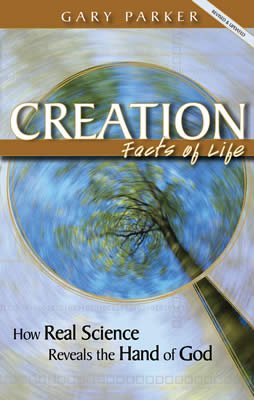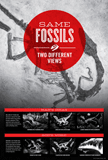
3.7 Summary: Fossil Kinds
The Fossil Evidence
As far as the fossil evidence is concerned, different kinds of animals and plants have always been different kinds of animals and plants, and people have always been people. It seems to me that “creation” is clearly the logical inference from our scientific knowledge of fossil kinds.
If the fossil evidence is as clear and simple as I’m suggesting it is, then even evolutionists would accept my description of the facts (even if they violently disagreed with my biblical inferences), and they do. At a rare conference of scientists from different specialties, leading evolutionists from around the world meeting in Chicago at least agreed on the same assessment of the fossil evidence reached (and predicted) by creationists long ago. As the summary in Newsweek put it (emphasis added):
Evidence from fossils now points overwhelmingly away from the classical Darwinism which most Americans learned in high school.1
In building up to that monumental conclusion (which should be posted as a plaque in all the nation’s science classrooms), the writer starts with man (emphasis added):
The missing link between man and the apes . . . is merely the most glamorous of a whole hierarchy of phantom creatures. In the fossil record, missing links are the rule. . . . The more scientists have searched for the transitional forms between species, the more they have been frustrated.
The concept of evolution touted in textbooks, then, is based on phantoms and figments of the imagination, not on fossils and the facts of science. In a landmark paper that helped pave the way for the Chicago conference, Gould and Eldredge2 put it this way: “Phyletic gradualism [gradual evolution] was an a priori assertion from the start [something believed ahead of time]; it was never ‘seen’ in the rocks.” Evolution was never seen in the rocks! Evolution is not a logical inference from scientific observations, because the observations were contrary to the theory right from the start, even as Darwin said.
If it wasn’t based on evidence or logic, then, where did the concept of evolution come from? Gould and Eldredge supply the answer: “It [gradual evolution] expressed the cultural and political biases of 19th century liberalism.” That’s what has been passed off in our school systems for 100 years as the “fact of evolution”—“the cultural and political biases of 19th century liberalism.”
When it comes to the fossil evidence, what are the facts? Believe it or not, when it comes to fossils, evolutionists and creationists now agree on what the facts are. The overwhelming pattern that emerges from fossils we have found is summarized in the word stasis. Stasis and static come from the same root word, a word that means “stay the same.” Gould and Eldredge are simply saying that most kinds of fossilized life forms appear in the fossil sequence abruptly and distinctly as discrete kinds, show relatively minor variation within kind, then often abruptly disappear.
Steven Stanley,3fossil expert from Johns Hopkins University, provided several examples of stasis. Elephants appear as a distinct group abruptly in the fossil sequence, diversify immediately into three subtypes, which then persist unchanged (except those which became extinct) without noticeably changing into anything else. Similarly, the modern horses (Equus) appear abruptly, Stanley said, “and their origin is not documented by known fossil evidence.” Stanley also noted that the excellent fossil history of bowfin fishes shows only trivial changes, and no basic shift of adaptation, making them very much like their descendants.
The victory of stasis over gradualism did not come easily at the Chicago conference. As Lewin4 mentioned in his professional summary for Science, “The proceedings were at times unruly and even acrimonious,” but, on the positive side, “many people suggested that the meeting was a turning point in the history of evolutionary thought.”
Perhaps the most dramatic response came from leading evolutionary geneticist Francisco Ayala. After admitting that neo-Darwinists “would not have predicted stasis from population genetics [extrapolation from mutation and selection],” he concluded, “but I am now convinced from what the paleontologists say that small changes do not accumulate” (emphasis added). No one finds it easy to change years of thinking, but a willingness to adapt theory to fact is the mark of a true scientist, and Ayala deserves a lot of credit for his statement.
When the dust finally settled, Gabriel Dover of Cambridge University summarized the Chicago conference by calling species stasis “the single most important feature of macroevolution.” Note, again, that at least the creationists and evolutionists agree on what the fossil facts represent, namely, stasis: sudden appearance of complete forms, minor variation, and sudden disappearance.
Perhaps you also detected a note of irony in Dover’s comment. If stasis means anything, it means staying the same; if evolution means anything, it means change. It seems to me, then, that evolutionists are actually saying (without quite meaning to, of course) that the most fundamental fact of their theory of change is that everything stays the same!
Creationists prefer a much more direct approach to the evidence. Each basic kind of plant and animal life appears in the fossil sequence complete, fully formed, and functional; each classifies according to the criteria we use to distinguish groups today, with “boundary problems” generally no greater nor different for extinct forms than for those living today; and each kind shows broad but quite finite ecologic and geographic variation within its kind. The most direct and logical inference (to a heart and mind open to the possibility) appears to be, it seems to me, creation, and variation within the basic created kinds. Differences such as extinction and decline in size and variety seem to point to corruption and catastrophe in the created order, not at all to “upward, onward” evolution.
When Darwin published Origin back in 1859, no one knew what discoveries would be made or what patterns would emerge in the new science of paleontology. On the basis of their theory and observations of heredity and reproduction, creationists predicted that only distinct kinds would be found, variation only within kind, and persistence of the criteria for classification. Evolutionists predicted a series of links would be found to show how complex types today evolved slowly and gradually from common ancestral stocks that finally blurred into simple, indistinct, and difficult-to-classify early forms.
The real test of a scientific theory is its ability to predict in advance of observation. When it comes to fossils, creation has passed the scientific test with flying colors. The original Darwinian theory of evolution and the neo-Darwinist and punctuationalist views have been disproved twice, both by genetics and by the fossil evidence.
In his final chapter, as he reviews his reasons for calling his book Evolution: A Theory in Crisis, Denton5 makes the following strong, sometimes harsh, statements:
We now know, as a result of discoveries made over the past thirty years, that not only is there a distinct break between the animate [living] and inanimate [non-living] worlds, but that it is one of the most dramatic in all nature, absolutely unbridged by any series of transitional forms [“missing links”], and like so many other major gaps of nature, the transitional forms are not only empirically absent but are also conceptually impossible [p. 347, emphasis added].
Similarly, the sorts of scenarios conjured up by evolutionary biologists to bridge the great divisions of nature, those strange realms of “pro-avis” or the “proto-cell” which are so utterly unrealistic to the skeptic, are often viewed by the believers [in evolution] as further powerful confirmatory evidence of the truth of the paradigm. Evolutionary thought today provides many other instances where the priority of the paradigm [i.e., the assumption that “evolution is fact”] takes precedence over common sense [p. 352, emphasis added].
For the skeptic or indeed to anyone prepared to step out of the circle of Darwinian belief, it is not hard to find inversions of common sense in modern evolutionary thought which are strikingly reminiscent of the mental gymnastics of the phlogiston chemists or the medieval astronomers [p. 351].
In a very real sense, therefore, advocacy of the doctrine of continuity [i.e., evolutionism] has always necessitated a retreat from pure empiricism [i.e., logic and observation], and contrary to what is widely assumed by evolutionary biologists today, it has always been the anti-evolutionists [i.e., creationists], not the evolutionists, in the scientific community who have stuck rigidly to the facts and adhered to a more strictly empirical approach. . . . It was Darwin the evolutionist who was retreating from the facts [p. 353–354 emphasis added].
On the positive side, Denton also notes that “there has always existed a significant minority of first-rate biologists who have never been able to bring themselves to accept the validity of Darwinian claims” (p. 327). At a conference in Sydney, Australia (April 1987), where we appeared on the platform together, Denton was willing to cautiously extrapolate that “significant minority” to “perhaps a majority” of first-rate biologists. He stressed also that those biologists willing to explore the design hypothesis do so for scientific reasons, apart from particular religious presuppositions (p. 341).
Creation-evolution was featured on CBS Television’s “Sunday Morning” (November 23, 1980) in a superb cover story put together by Richard Threlkeld6 (who ranks up there with CBC’s Tom Kelly as a fair, honest, thoughtful, and thought-provoking TV journalist). The 20-minute piece starts with my students and me “in the act of discovery,” hunting fossils in the desert east of San Diego. It continues with several evolutionists, other creationists, parents, students, and teachers in action and includes a computer graphic series depicting evolution.
Threlkeld makes the inevitable trip to the site of the famous Scopes “monkey trial,” but he does not allow his thinking to be buried there. “The debate goes on,” he observes, “and why not?” After all, nobody was there to see how life came into being, he says; at bottom both views are assumptions. But he doesn’t stop thinking there, either. Instead, he treats the two ultimate assumptions, creation and evolution, as ideas which can be compared for their scientific merits and which must be compared before we can truly appreciate our origin as human beings.
Creation: Facts of Life
Dr. Parker, a leading creation scientist and former AiG speaker, presents the classic arguments for evolution used in public schools, universities, and the media, and refutes them in an entertaining and easy-to-read style. A must for students and teachers alike! This is a great book to give to a non-Christian as a witnessing tool.
Read OnlineFootnotes
- Adler and Carey, “Is Man a Subtle Accident?”
- Stephen Jay Gould and Niles Eldredge, “Punctuated Equilibria: The Tempo and Mode of Evolution Reconsidered,” Paleobiology (June/July 1977).
- Steven M. Stanley, “Darwin Done Over,” The Sciences (October 1981).
- Lewin, “Evolutionary Theory Under Fire.”
- Michael Denton, Evolution: A Theory in Crisis (London: Burnett Books, 1985).
- Richard Threlkeld, CBS Television, “Sunday Morning” (November 23, 1980).
Recommended Resources

Answers in Genesis is an apologetics ministry, dedicated to helping Christians defend their faith and proclaim the good news of Jesus Christ.
- Customer Service 800.778.3390
- © 2024 Answers in Genesis



